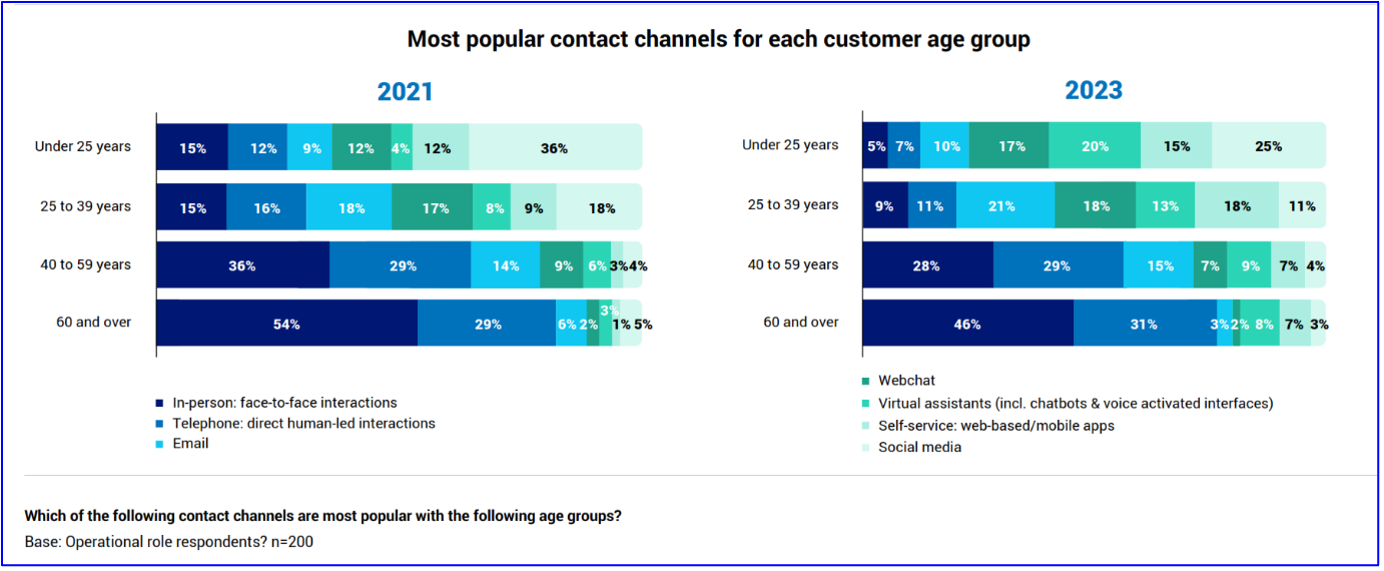For years, contact center, and then CCaaS, vendors have shouted the message loud and clear, “voice is not dead.” Even in the past three years, this site has run articles from practitioners who say that voice is still the preferred channel for the customer experience. Well, it is more than time for all of us to admit that the decline in voice traffic into contact centers has begun.
I hear the naysayers among you saying that the death of voice has been heralded for years now. Yes, but now the data increasingly supports the hypothesis, especially in specific demographic groups.
Voice is on the Decline
According to the NTT 2023 Global Customer Experience Report, those under 40 are open to an ever-widening variety of contact channels. Also, the trend of those aged 40+ accepting less traditional channels continues, although for now, human-led channels are still their main preference.
The graphs below paint the picture. According to the NTT study, the preference for human-led, telephone interactions declined over the period from 2021 to 2023 from 12% to 7% for those under 25 years old and from 18% to 11% for customers between 25 and 39 years old. Note that in the 40 to 59 years group the telephone percentage stayed steady over the period and for those sixty and over, actually increased slightly, from 29% to 31%.
The premise of this article, the decline of voice interactions in the contact center, was echoed in the comments of Alan Masarek, CEO, Avaya during an SCTC fireside chat with fellow No Jitter contributor Steve Leaden, on December 13, 2023. “I would say voice to digital,” Masarek stated when discussing the big trends that are happening in the enterprise software market.
In most contact centers, a meaningful majority of interactions are still voice, Masarek said. However, that majority is not considered a timeless certainty. “Everybody is pursuing the same objectives of cost containment, call deflection, and using AI for more intelligent voice bots. They are moving more interaction traffic to digital. We all know that,” Masarek continued.
Digital Engagement is on the Rise
Not only is the use of voice declining for some age groups, but the number of digital channels used by any single company to interact with customers is also rising. Contact centers surveyed by NTT in 2023 report an average of 8 interaction channels in use per organization. This includes a growing use of social media, mobile applications, chatbots, and WhatsApp. “The traditional role of the voice-based call center is now just one piece of the puzzle,” summarizes NTT.
Recent data from two CCaaS leaders support NTT’s data.
- During NICE’s Q3 2023 earnings call, Barak Eilam, CEO, reported the company’s digital engagement bookings grew 78% year-over-year and that, “digital engagement and CX AI are the fastest growing segments of our pipeline, increasing sevenfold year-over-year and representing a significant part of our new business pipeline.”
- In a press release December 14th, Genesys announced the number of digital interactions on the Genesys Cloud platform grew nearly 3X year-over-year.
Delivering Agile Any-Channel Engagement
Notice my use of the phrase “any-channel” above. No, I am not trying to define a new term of art. I am, however, consciously NOT using omnichannel. I think that word has been polluted over the past ten years or so – being used in different ways by different companies – and thus it adds more confusion than clarity about what consumers are looking for and how they prefer to interact with companies.
As organizations look to 2024, they should be defining how they will address this shift from mainly voice to a healthy mix of voice and digital engagement in their customer experience strategy. I believe the marketing messages of some CCaaS vendors employ terminology that can be useful in creating a mindset for how customer experiences should be delivered.
- Five9 has begun to use talk about helping customers create “fluid experiences.”
- NICE has used the term “frictionless” to describe the ideal customer experience.
The ideal experience should be one that can start in either an assisted or self-service channel and move easily from one to another, with context. This should ultimately mean breaking down today’s typical contact center agent silos, where there are voice agents and digital ones. The same agent should be able to talk to you on the phone, text you a link and email you a receipt – seamlessly.
Offer the Right Any-Channel Mix
I will conclude with a word of caution. Taking on too many channels and touchpoints can be overwhelming for consumers. According to the NTT Global CX Report, voice coupled with chat, email and social media is becoming the norm. That will vary by vertical industry and region of the world, but the goal is not necessarily to offer EVERY channel but the right mix for your customers.
Want to know more?
For more on this and other topics related to the customer experience, check out How Changes in the CX Market in 2023 Will Play Out in 2024. Hosted on LinkedIn Live, the session features Sheila McGee-Smith and Verint experts Dave Singer and Jaime Meritt. The session goes live on Tuesday, Jan 9, 2024, at 1:00 PM ET.











